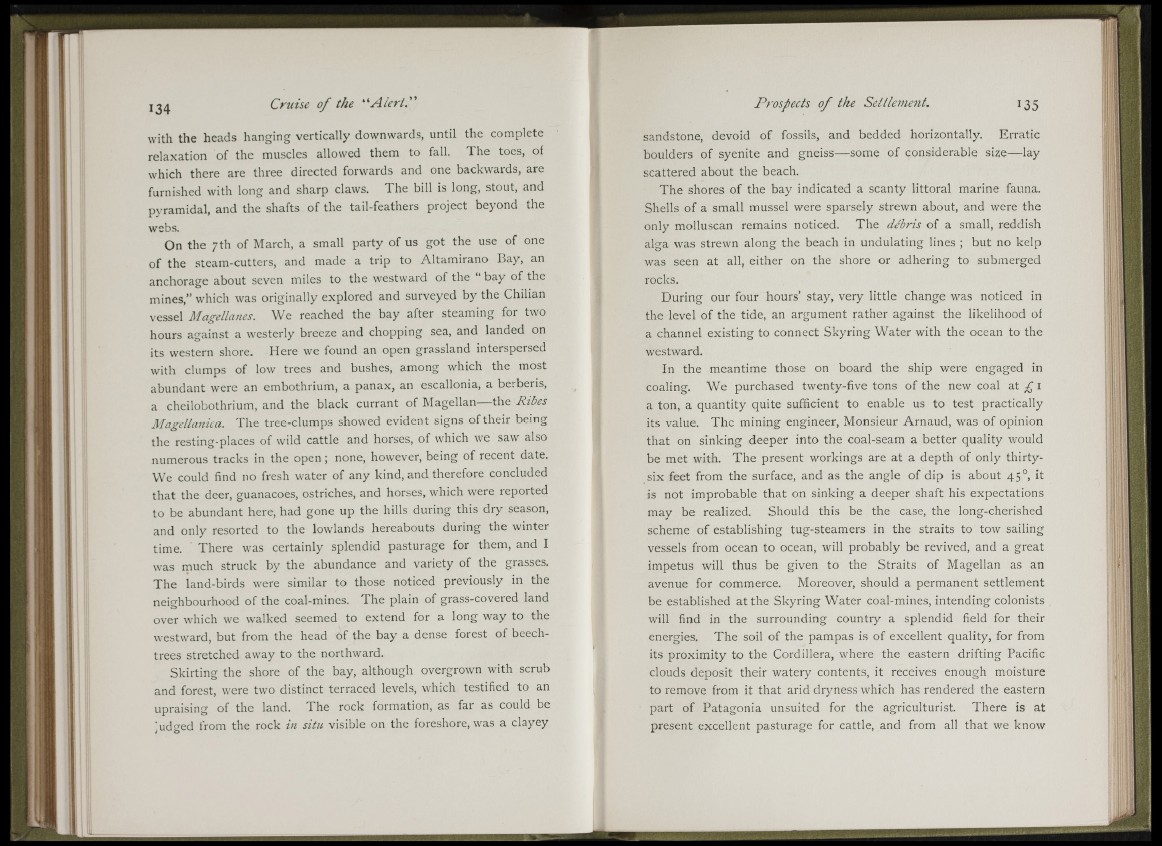
with the heads hanging vertically downwards, until the complete
relaxation of the muscles allowed them to fall. The toes, of
which there are three directed forwards and one backwards, are
furnished with long and sharp claws. The bill is long, stout, and
pyramidal, and the shafts of the tail-feathers project beyond the
webs.
On the 7th of March, a small party of us got the use of one
of the steam-cutters, and made a trip to Altamirano Bay, an
anchorage about seven miles to the westward of the “ bay of the
mines,” which was originally explored and surveyed by the Chilian
vessel Magellanes. We reached the bay after steaming for two
hours against a westerly breeze and chopping sea, and landed on
its western shore. Here we found an open grassland interspersed
with clumps of low trees and bushes, among which the most
abundant were an embothrium, a panax, an escallonia, a berberis,
a cheilobothrium, and the black currant of Magellan— the Ribes
Magellanica. The tree-clumps showed evident signs of their being
the resting-places of wild cattle and horses, of which we saw also
numerous tracks in the open ; none, however, being of recent date.
We could find no fresh water of any kind, and therefore concluded
that the deer, guanacoes, ostriches, and horses, which were reported
to be abundant here, had gone up the hills during this dry season,
and only resorted to the lowlands hereabouts during the winter
time. There was certainly splendid pasturage for them, and I
was much struck by the abundance and variety of the grasses.
The land-birds were similar to those noticed previously in the
neighbourhood of the coal-mines. The plain of grass-covered land
over which we walked seemed to extend for a long way to the
westward, but from the head of the bay a dense forest of beech-
trees stretched aw'ay to the northward.
Skirting the shore of the bay, although overgrown with scrub
and forest, were two distinct terraced levels, which testified to an
upraising of the land. The rock formation, as far as could be
‘udf^ed from the rock in situ visible on the foreshore,i was a clayey
Prospects o f the Settlement. 135
sandstone, devoid of fossils, and bedded horizontally. Erratic
boulders of syenite and gneiss— some of considerable size— lay
scattered about the beach.
The shores of the bay indicated a scanty littoral marine fauna.
Shells of a small mussel were sparsely strewn about, and were the
only molluscan remains noticed. The débris of a small, reddish
alga was strewn along the beach in undulating lines ; but no kelp
was seen at all, either on the shore or adhering to submerged
rocks.
During our four hours’ stay, very little change w'as noticed in
the level of the tide, an argument rather against the likelihood of
a channel existing to connect Skyring Water with the ocean to the
westward.
In the meantime those on board the ship were engaged in
coaling. We purchased twenty-five tons of the new coal at £ I
a ton, a quantity quite sufficient to enable us to test practically
its value. The mining engineer. Monsieur Arnaud, was of opinion
that on sinking deeper into the coal-seam a better quality would
be met with. The present workings are at a depth of only thirty-
six feet from the surface, and as the angle of dip is about 45°, it
is not improbable that on sinking a deeper shaft his expectations
may be realized. Should this be the case, the long-cherished
scheme of establishing tug-steamers in the straits to tow sailing
vessels from ocean to ocean, will probably be revived, and a great
impetus will thus be given to the Straits of Magellan as an
avenue for commerce. Moreover, should a permanent settlement
be established at the Skyring Water coal-mines, intending colonists
will find in the surrounding country a splendid field for their
energies. The soil of the pampas is of excellent quality, for from
its proximity to the Cordillera, where the eastern drifting Pacific
clouds deposit their watery contents, it receives enough moisture
to remove from it that arid dryness which has rendered the eastern
part of Patagonia unsuited for the agriculturist. There is at
present excellent pasturage for cattle, and from all that we know
ii P::
liu